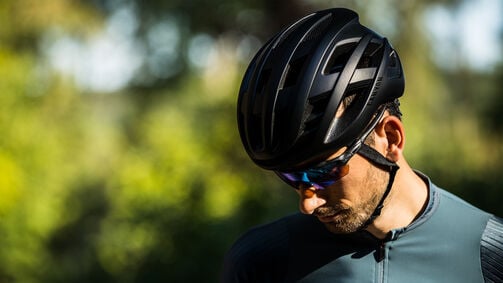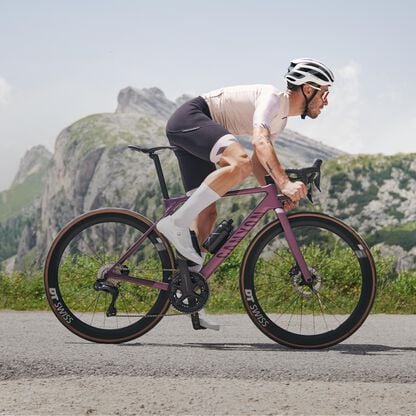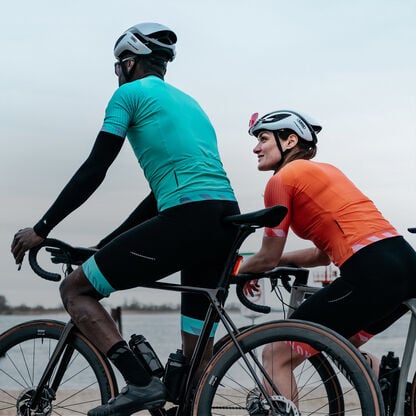How to choose a bike helmet: A buyer's guide to finding the perfect fit
Looking for a new road or mountain bike helmet but not sure where to start? Here’s everything you need to know to get the best bicycle helmet for you.


Wherever and however you ride, a good bicycle helmet is at the core of your cycling experience. Thanks to modern technology, today’s helmets are lighter, safer, more comfortable. Stylish too. With so many choices though, finding the right one can be tricky.
But, you’re in the right place. Our bike helmet buying guide covers everything from safety standards and fit to aerodynamics and style, helping you find the best cycle helmet for your ride.
Contents
Why a bicycle helmet is essential
Wearing a properly fitted, high-quality helmet is the simplest and most effective thing you can do to protect your head while riding. Designed to dissipate impact energy during a crash, a good bike helmet will dramatically reduce the force transmitted to your skull and brain. At Canyon, we believe it’s essential to wear a helmet even during short, routine rides, here’s a few reasons why.
Head injury reduction
Some studies suggest that wearing a helmet can reduce the risk of head injury by as much as 48%, serious head injury by 60% and fatal head injury by up to 71%.
Impact absorption
Inside a plastic outer shell, good bicycle helmets use expanded polystyrene (EPS) foam, which breaks apart or compresses under pressure. This transfers the energy of an impact, reducing the acceleration of the head and preventing the skull and brain from bearing the full brunt of a fall or collision.
Rotational impact
More common and at times even more damaging are angled impacts, in which rotational forces can twist the brain inside the skull. The best bicycle helmets incorporate rotational impact technologies designed specifically to help mitigate these rotational forces too.
Legal requirements
In many areas, helmet use is a legal requirement – especially for children and teens.
Even minor crashes can cause severe damage and simply put, no piece of equipment is more likely to save your life than a good bicycle helmet. Different helmets offer varying levels of coverage based on the demands of the riding style so when choosing a helmet, you’ll need to consider the type of riding you do most. More on this later.

Advanced impact protection (Mips and more)
In a crash, a good bike helmet will protect against more than just direct impact. Rotational forces due to angled impact can lead to concussion or brain injury. Many modern helmets are now engineered to protect against both linear and rotational accelerations.
Rotational impact protection technologies, like Mips (Multi-directional Impact Protection System), are designed to reduce these forces by allowing the helmet to move slightly on impact, reducing the amount of rotational forces transmitted to your head, and helping protect your brain. You’ll find the small, yellow Mips logo affixed to many modern, high-quality helmets.
How Mips works
Inside the helmet, Mips is a low-friction layer that lets your head move 10-15mm relative to the shell, reducing rotational force to the brain. It adds a little weight (25-45g) and cost, but many tests indicate that it offers a significant boost in protection, making Mips a smart feature to look for.
Other rotational systems in bike helmets
While Mips is the most recognisable and most commonly used across good bike helmet manufacturers, there are a number of alternatives you may come across in cycling helmets.
- WaveCel: A cellular structure designed to flex and compress upon impact to reduce rotational forces and prevent brain injuries.
- SPIN: A technology using pads that move inside the helmet to manage rotational energy.
- Koroyd: Tube-based energy absorption technology replacing EPS in some helmets.
- Spherical technology: A dual-density ball and socket foam system designed to integrate the helmet with Mips.
How each system works is slightly different, but ultimately any rotational protection is better than none.
Understanding bike helmet safety standards
With so many helmet manufacturers out there, safety certifications are your first sign of a trusted, and properly tested product. Standards vary by region, so understanding them helps ensure you're getting the right protection wherever you ride.
- CPSC: Mandatory for all helmets sold in the US, testing impact absorption and strap strength.
- EN 1078: The European standard, with similar but slightly different testing protocols.
- AS/NZS 2063: The Australian/New Zealand standard, common in international helmet models.
- Snell B-95: A voluntary certification with more demanding impact tests and higher standards.
All recommended helmets carry at least one safety certification, and top-rated road and mountain bike helmets often meet several. Always check for a certification label inside the helmet, on the shell, or chinstrap. If it’s missing, ask – certified protection is non-negotiable.
What makes a bike helmet safe besides certifications?
With bold manufacturer claims, ever-evolving technology, and a range of certifications, identifying the safest helmets is increasingly complex. That’s where independent, unbiased testing comes in.
In a dedicated helmet lab, since 2011 Virginia Tech University has been testing helmets across various sports. Each helmet undergoes 24 separate impact tests, measuring both linear acceleration and rotational velocity, offering a more rigorous, real-world assessment. The results are compiled to form a ranked list using their STAR rating system, making it easy to find the safest, best-performing helmets.
Are expensive bike helmets actually safer than budget options?
Price doesn't always correlate with safety. Thanks to minimum safety standards, most good affordable cycle helmets meet the same safety standards as premium models. More expensive helmets however are often lighter, offer better comfort features and advanced rotational protection systems.
Types of bike helmets for every rider
Whether it's the speed and aerodynamics of road cycling or the extended protection needed for mountain biking, each discipline calls for different helmet needs. The best cycling helmet for you depends on how and where you ride.

Road and aero helmets – built for speed, comfort, and all-day performance
Your helmet is one of the first points of contact with the air, so its shape, fit, and ventilation all have a major impact on your speed, comfort, and cooling. But when it comes to choosing the best road bike helmet, most top-tier designs share a few essential features:
- Less coverage for a lightweight construction (200–300g)
- Maximum airflow through large, efficient vents
- Aerodynamic profiles for cutting through wind
While all performance road helmets aim to balance these core elements, the best cycling helmet for you depends on your riding style. Recreational road cyclists, for example, will benefit most from comfort, cooling, and value, while endurance riders and tourers should look for all-day comfort and durability. Competitive riders will want ultra-light, aero-optimised helmets to maximise performance while time time-trialists and triathletes can unlock serious speed with dedicated aero helmets.
Aero gains without compromise
Designed developed and tested alongside our pro athletes, Canyon has developed two performance road helmets in partnership with leading experts in aerodynamics. The result? Two of the most advanced and arguably coolest cycle helmets on the market today.
Disruptr CFR – Aero meets all-day ventilation
For riders who want aero advantages without sacrificing airflow, the Disruptr CFR is the perfect choice. With enhanced ventilation and smart aerodynamic shaping, it’s designed for long, hot days in the saddle, making it one of the coolest cycle helmets for endurance and stage racing alike.
Stingr CFR – Pure aero performance
Designed to slice through the wind, the Stingr CFR features a fully optimised aerodynamic shape and a revolutionary strapless HighBar retention system. Lab-tested to save up to 10–20 watts at 60–70 kph, it can gain you up to 33 seconds over 100 km. It’s an athlete-proven helmet to save you valuable watts when it matters most.

Mountain bike helmets – protection and confidence for every trail adventure
More coverage = more protection and for mountain biking in uneven, dynamic terrain, it’s all about maximising protection. Typical features you’ll see across all good mountain bike helmets are:
- More coverage for better protection
- Visors to shield from sun and debris
- More robust construction for trail impacts
- Often include Mips or similar rotational protection
Deflectr – ultimate protection and unrivalled comfort
From backcountry epics to bike park laps, the Canyon Deflectr trail helmet sets the new benchmark for off-road biking helmets, with a well-executed design and breakthrough RLS technology that’ve helped it earn a top, five-star rating at the Virginia Tech helmet lab. Developed by HEXR, RLS (Release Layer System) and debuting on the Canyon Deflectr, RLS represents a monumental leap in helmet technology.
“RLS” stands for Release Layer System. Helmets with RLS feature dual shells separated by a release layer membrane. The membrane is covered with bearings. The bearings are covered in a specially-tuned adhesive that allows the second shell to detach when impact energy goes beyond a set limit. On impact, those bearings allow extra movement between the shells, decreasing the amount of rotation transferred to a rider’s head during a crash. In fact, in certain impacts, the Deflectr’s outer RLS panels detach, reducing harmful rotational forces.
We also perfected the Deflectr’s exterior shape and interior contours, creating an extended-coverage helmet that still feels light and sleek, with outstanding fit adjustability and sweat management, we’ve designed the ultimate helmet for maximum protection and all-day comfort.

Gravel bike helmets – lightweight freedom for endless exploration
Taking the speed of the road onto the trails, the best gravel helmets blend the essentials of road and mountain biking helmets. The features to consider are:
- Lightweight design for long-distance comfort;
- Balanced ventilation for both road speed and off-road climbs;
- Streamlined shape, often without large visors;
- Mips or similar technology for reducing rotational forces; and
- A blend of road aerodynamics and MTB durability
Whether you’re looking for the gnarliest gravel descents or looking to weave in a few fire roads to your usual tarmac loops, the best gravel helmet for you will depend on exactly what gravel riding means to you.

Good bike helmets for recreational riders: Commuter/urban helmets
For the daily commute or family outings, a good helmet for casual cycling is all about everyday practicality, prioritising comfort, easy adjustability, and these user-friendly features:
- Stylish designs that suit every day clothing;
- Integrated lights or reflective elements; and
- Durable construction for daily use
The key for recreational riders is a secure fit and reliable protection, meeting safety certifications without the need for high-end performance extras.
How to find your ideal bike helmet fit and size
Even the highest-rated or coolest looking helmet won’t protect you as effectively as it should if it doesn’t fit properly. Fit can vary a lot between brands, even within the same size, so always try before you buy or check sizing guides carefully, and be sure to adjust both the chin straps and, if present, the adjustable retention system (look for a dial at the rear of the helmet) as well.
Measuring head circumference
To make sure you get the right fit, it’s important you’re able to measure the right part of your head correctly:
- Use a flexible measuring tape or string
- Measure around the largest part of your head, about 1 inch above your eyebrows
- Take the measurement in centimetres for most accurate sizing
- Compare to manufacturer size charts, as sizing varies between brands
| Head Circumference | Typical Size |
|---|---|
| 51-55 cm | Small |
| 55-59 cm | Medium |
| 59-63 cm | Large |
| 63+ cm | Extra large |
Adjusting straps and retention systems
A good adult bike helmet offers adjustable straps and a retention system to fine-tune the fit within the correct size range. But what does a proper fit actually look like?
- Helmet should sit level on your head, low on your forehead (about two finger-widths
- above eyebrows);
- Side straps should form a ‘Y’ shape around your ears;
- Chin strap should be snug but comfortable, allowing only one finger underneath; and
- Retention dial should be fine-tuned (twisted) so the helmet doesn't rock forward or backward
Do men and women need different types of helmets?
The best helmets for men and women are not necessarily gender specific. Women often tend to have smaller and more round heads than men, but everyone is different, so look for a helmet that fits securely and has enough adjustment, whilst feeling and looking good for you.
Comparing bike helmet features and comfort
Comfort features like padding, ventilation, and adjustability make a big difference in how often you actually wear your helmet – which matters, because it only protects you if it’s on your head. A helmet that feels good is one you’ll wear every ride.
Ventilation and weight balance
More vents improve airflow but may reduce coverage and structural strength. A well-designed helmet strikes the right balance between ventilation, weight, and protection to keep you cool and comfortable on long rides. Consider the level of ventilation based on your riding needs:
- Hot climates: Maximum ventilation for cooling.
- Cooler conditions: Moderate ventilation is usually sufficient.
- High-speed riding: Aero helmets reduce drag but may sacrifice some airflow for performance gains.
Padding materials and sweat management
Inside the helmet, padding adds more than just comfort, it also enhances fit, hygiene, and overall ride quality. The best bike helmets include moisture-wicking pads to keep sweat out of your eyes on the longest rides, and are fully removable for easy cleaning. Some even include multiple pad thicknesses for a custom fit, and antimicrobial treatments to reduce odour and keep your helmet fresher for longer.
When to replace your helmet
Even if it looks fine, staying on top of your helmet’s condition is crucial. Here are the signs it's time for a replacement:
- A Crash: Even if the helmet appears undamaged, the EPS foam may have compressed.
- 5-years old: Materials degrade from UV exposure, sweat, and normal wear.
- Visible damage: Cracks, dents, or crushed foam require immediate replacement.
- Strap Wear: Broken or fraying straps compromise helmet retention.
- Poor Fit: If the helmet no longer fits properly due to wear or head size changes.
How often should I inspect my helmet for damage?
Check your helmet before every ride for cracks, crushed foam, or strap damage. Each month, do a deeper inspection for UV damage or wear that could weaken its protection.
Maintaining and cleaning your cycling helmet for longevity
With proper care, your helmet should last plenty of time. The best way to extend its lifespan is to store it safely and clean it regularly using the following guide:
- Remove all removable padding and straps if possible.
- Hand wash padding with mild soap and warm water.
- Clean the shell with damp cloth and mild detergent.
- Air dry completely before reassembly – never use heat sources.
- Inspect for cracks or damage during each cleaning.
For safe storage, aim for cool, dry places away from direct sunlight and avoid leaving in hot cars or direct heat. Use a helmet bag to prevent scratches during transport and keep it away from chemicals and solvents.
Where Canyon fits into your riding journey
At Canyon, rider safety and performance go hand in hand. A high-quality helmet is a key part of that equation, working alongside our precision-engineered bikes to deliver a complete, confident ride to maximise your experience and your performance. Choosing the right helmet ensures you're getting the most out of your ride, without compromising on safety.
So gear up, ride smart, and we’ll see you out on the roads, trails, and streets - ready to chase every adventure.
Did this article help?
Thank you for your feedback
-
 About the author
About the authorChris Hunt
Chris is a freelance writer, communications head, and adventure cyclist based in Bristol, UK. Working in a bike shop as a teenager was his gateway to clocking up countless miles, embracing various shapes of bicycle, from couriering on cargo bikes to multi-day off-road bikepacking journeys. With over a decade of experience in adventure media, he cut his teeth first as a journalist in surf media before becoming editor of at BASE magazine. These days, his work revolves around cycling: reviewing gear, documenting rides, and helping develop long-distance routes. He’s also the founder of Pinch Flat Journal, an online magazine celebrating alternative cycling culture. In 2025, after years of following the event, he rode the 11th Transcontinental Race, covering 5,000 km from Spain to Romania in 17 days.










